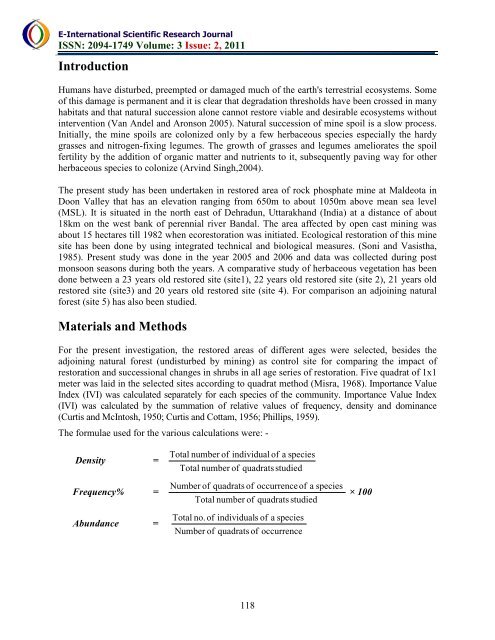download the full article here - E-International Scientific Research ...
download the full article here - E-International Scientific Research ...
download the full article here - E-International Scientific Research ...
Create successful ePaper yourself
Turn your PDF publications into a flip-book with our unique Google optimized e-Paper software.
E-<strong>International</strong> <strong>Scientific</strong> <strong>Research</strong> Journal<br />
ISSN: 2094-1749 Volume: 3 Issue: 2, 2011<br />
Introduction<br />
Humans have disturbed, preempted or damaged much of <strong>the</strong> earth's terrestrial ecosystems. Some<br />
of this damage is permanent and it is clear that degradation thresholds have been crossed in many<br />
habitats and that natural succession alone cannot restore viable and desirable ecosystems without<br />
intervention (Van Andel and Aronson 2005). Natural succession of mine spoil is a slow process.<br />
Initially, <strong>the</strong> mine spoils are colonized only by a few herbaceous species especially <strong>the</strong> hardy<br />
grasses and nitrogen-fixing legumes. The growth of grasses and legumes ameliorates <strong>the</strong> spoil<br />
fertility by <strong>the</strong> addition of organic matter and nutrients to it, subsequently paving way for o<strong>the</strong>r<br />
herbaceous species to colonize (Arvind Singh,2004).<br />
The present study has been undertaken in restored area of rock phosphate mine at Maldeota in<br />
Doon Valley that has an elevation ranging from 650m to about 1050m above mean sea level<br />
(MSL). It is situated in <strong>the</strong> north east of Dehradun, Uttarakhand (India) at a distance of about<br />
18km on <strong>the</strong> west bank of perennial river Bandal. The area affected by open cast mining was<br />
about 15 hectares till 1982 when ecorestoration was initiated. Ecological restoration of this mine<br />
site has been done by using integrated technical and biological measures. (Soni and Vasistha,<br />
1985). Present study was done in <strong>the</strong> year 2005 and 2006 and data was collected during post<br />
monsoon seasons during both <strong>the</strong> years. A comparative study of herbaceous vegetation has been<br />
done between a 23 years old restored site (site1), 22 years old restored site (site 2), 21 years old<br />
restored site (site3) and 20 years old restored site (site 4). For comparison an adjoining natural<br />
forest (site 5) has also been studied.<br />
Materials and Methods<br />
For <strong>the</strong> present investigation, <strong>the</strong> restored areas of different ages were selected, besides <strong>the</strong><br />
adjoining natural forest (undisturbed by mining) as control site for comparing <strong>the</strong> impact of<br />
restoration and successional changes in shrubs in all age series of restoration. Five quadrat of 1x1<br />
meter was laid in <strong>the</strong> selected sites according to quadrat method (Misra, 1968). Importance Value<br />
Index (IVI) was calculated separately for each species of <strong>the</strong> community. Importance Value Index<br />
(IVI) was calculated by <strong>the</strong> summation of relative values of frequency, density and dominance<br />
(Curtis and McIntosh, 1950; Curtis and Cottam, 1956; Phillips, 1959).<br />
The formulae used for <strong>the</strong> various calculations were: -<br />
Density =<br />
Frequency% =<br />
Abundance =<br />
Total number of individual of<br />
Total number of<br />
Total number of<br />
a species<br />
quadrats studied<br />
Number of quadrats of occurrenceof a species<br />
Total no. of<br />
quadrats studied<br />
individuals of a species<br />
Number of quadrats of occurrence<br />
× 100<br />
118

















